|
Common names:
China |
Chinese Mandarin |
卡路弹涂鱼, 卡路彈塗魚 (Ka lu tan tu yu - Kalu mudskipper) |
Denmark |
Danish |
Almindelig dyndspringer |
Guam |
English |
Common mudskipper |
Italy |
Italian |
perioftalmo kalolo* |
Mauritius |
Creole, French |
Cabot |
Mauritius |
English |
Silverline mudskipper |
Micronesia |
English |
Kalolo mudskipper |
Papua New Guinea |
English |
Sailfin mudskipper |
Philippines |
Tagalog |
Bia |
South Africa |
English |
African mudhopper |
South Africa |
Afrikaans |
Afrikaanse modderspringer |
* proposed name
|
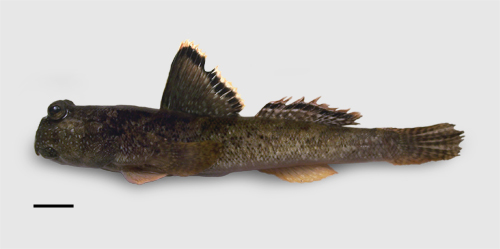
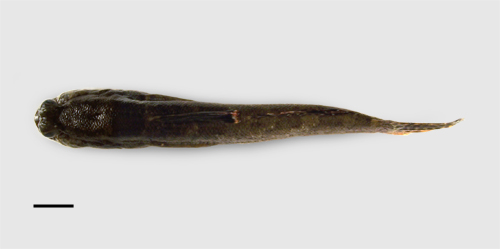
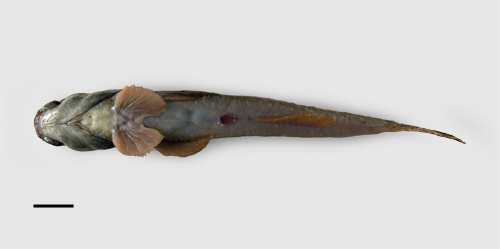
Periophthalmus kalolo. Bajo, North Sulawesi, Indonesia;
lateral view (above); dorsal view (centre); ventral view (below);
the bar is 10 mm long - freshly dead specimen, female (photo: G. Polgar, 2005)
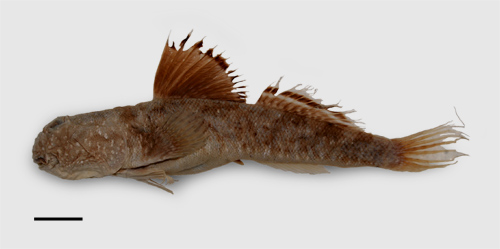
Periophthalmus kalolo. RMNH 4754, coll. Bleeker 1879
possible syntype of Periophthalmus kallopterus Bleeker, 1853
Ambon, Moluccas, Indonesia;
lateral view (above); dorsal view (centre); ventral view (below);
the bar is 10 mm long - specimen fixed and preserved in ethanol, male
(photo: G. Polgar, 2007)
|
|
Synonyms:
|
Periophthalmus kalolo |
Lesson, 1831 |
(senior syn., original combination) |
|
Periophthalmus kallopterus |
Bleeker, 1853 |
(junior synonym) |
|
Periophthalmus fuscatus |
Blyth, 1858 |
(junior synonym) |
|
Periophthalmus harmsi |
Eggert, 1929 |
(junior synonym) |
|
Periophthalmus koelreuteri africanus |
Eggert, 1935 |
(junior synonym)* |
|
Periophthalmus koelreuteri albostriatus |
Eggert, 1935 |
(junior synonym)* |
|
Periophthalmus koelreuteri kalolo |
Eggert, 1935 |
(junior synonym)* |
|
Periophthalmus koelreuteri koelreuteri |
Eggert, 1935 |
(junior synonym)* |
|
Periophthalmus koelreuteri velox |
Eggert, 1935 |
(junior synonym)* |
|
Periophthalmus musgravei |
Whitely, 1961 |
(junior synonym) |
*sensu Eggert (1935)
Type catalog
(last update: 15/08/2007)
Etymology:
'Periophthalmus' is a compound name from the Greek 'peri' (around), and 'ophthalmôn' (eye), which refers to the wide visual field of these species
the specific name is the native name for this species in Waigeo, Irian Jaya, Indonesia (Lesson, 1831)
|
Maximum recorded length:
141 mm SL (Murdy, 1989)
Live colouration
(Murdy, 1989, based on photo F; pers. obs.:
North Sulawesi, Indonesia):
background colour light brown to greyish on head, dorsum and flanks, ventrally paler; small black speckles and larger white speckles on flanks; numerous white spots on snout, cheeks and opercula; 3-6 black to dark brown very irregular saddle-like diagonal bars may be visible on dorsum. D1 membrane dark brown, with numerous white spots in the posterior and proximal portion, a black submarginal stripe, and a
white margin; D2 proximally grey to brown with small white spots, a medial dark brown stripe sandwiched by two white stripes, and a red margin; caudal fin dusky, with series of dark brown speckles along rays;
anal fin white to orange; pelvic fins hyaline to pinkish; pectoral fins dusky with series of brown speckles on rays
Colouration on preservation
(Murdy, 1989; pers. obs.):
background colour dorsally and laterally grey to brown, ventrally paler; white spots on head may be preserved; black speckles on flanks; dark dorsal banded pattern frequently not visible. D1 dark grey to brown with white spots proximally and posteriorly, a black submarginal stripe, and a pale margin;
D2 proximally dark brown with whitish flecks, a blackish inframarginal stripe and a pale margin; caudal and pectoral fins dusky with series of
dark speckles on rays; pelvic
and anal fins hyaline
Diagnosis (Murdy, 1989):
D1 XI-XV; total D2 elements 12-13; total anal fin elements 11-12; longitudinal scale count 66-86; TRDB 18-22; pelvic fins united
for about one third of the length of their innermost rays, and with a strong frenum; D1 margin convex; dorsal fins not connected by membrane; colouration traits of D1 and D2.
The genus is yet undefined by synapomorphies
Diet:
Brillet (1984b) studied the habitat and behaviour of P. kalolo from Madagascar: this species is carnivorous (crustaceans and other arthropods). Stebbins & Kalk, 1961 and Macnae & Kalk, 1962 studied the gut content of P. sobrinus (= P. argentilineatus) in Madagascar, finding crustaceans, insects and polychaetes; nonetheless, it is probable that they didn't discriminate between this species and P. kalolo, which are sympatric in this region (Clayton, 1993)
|
|
Reproduction:
Brillet (1984a) compared the courtship behaviours of P. kalolo (= P. koelreuteri africanus Eggert) and P. argentilineatus (= P. sobrinus Eggert) from Madagascar, finding them very similar
|
|
|
|
|
Ecological notes (pers. obs.: North Sulawesi, Indonesia):
locally abundant in the low intertidal zone, where the influence of the sea is dominant, in full sea water, even on sandy substrates
left: estuary of the small river Bajo, nearby a rocky promontory and behind a coral reef: here P. kalolo was found
nearby some stunted trees of Sonneratia alba, where the influence of fresh water was minimal (North Sulawesi, Indonesia)
right: Liang beach, a small stand of Sonneratia alba on sand-mud sediments; also here this species was abundant (Bunaken Is., North Sulawesi, Indonesia)
(photos: G. Polgar, 2005)
|
|
|
|
|
Distribution (Murdy, 1989):
recorded from East Africa to Samoa; type locality: Waigeo, Irian Jaya, Indonesia (the type material of P. kalolo Lesson is presumably lost; Murdy 1989)
|
|
|
Remarks:
Periophthalmus kalolo and P. argentilineatus, two frequently sympatric and syntopic species, are often incorrectly discriminated and confused one with each other. According to the present scientific consensus (Murdy 1989; pers. obs.), P. kalolo presents: 1) a strong pelvic frenum (absent or only visible with magnification in P. argentilineatus); and 2) pelvic fins fused by a basal membrane for about 1/2 the length of the innermost rays (completely separated or fused for less than 1/3 the length of the inner rays in P. argentilineatus). Therefore, to discriminate these species specimens must be observed at a closed distance and in ventral view.
Before Murdy's
revision (1989), Eggert (1935) synonymised P. kalolo Lesson with P. koelreuteri (Pallas), adding 5 subspecies. Nonetheless, although P. kalolo Lesson is consistent with the description of the new combination P. koelreuteri (Pallas) by Bloch & Schneider (1801), it is inconsistent with the original description of Gobius koelreuteri Pallas (see also Remarks in P. barbarus). In fact, Eggert (1935) reportedly followed a detailed redescription of P. koelreuteri (Pallas) by Cuvier and Valenciénnes (1837), consistent with P. kalolo Lesson ("... les deux nageoires qui la composent ne sont réunies que par une membrane de moitié plus courte;"). Nonetheless, the original description by Pallas (1770) has priority over subsequent redescriptions or modifications.
Murdy (1989) did not recognise G. koelreuteri Pallas [hence P. koelreuteri (Pallas)] as a synonym of P. kalolo Lesson; therefore he 1) considered that the description of G. koelreuteri Pallas corresponded to another species, namely G. barbarus Linnaeus, hence naming this species P. barbarus (Linnaeus); and 2) synonymised the 5 subspecies of P. koelreuteri (Pallas) described by Eggert (1935) as junior synonyms of P. kalolo Lesson.
Brillet, who studied the behaviour of P. argentilineatus and P. kalolo in Madagascar for several years, was initially unable to discriminate them, identifying them as "P. koelreuteri Pallas". After 8 years from his first publication on these species, Prof. Roux showed him (Brillet, 1975) that he was actually observing two different species, exhibiting similar but different behavioural patterns: P. koelreuteri africanus Eggert (= P. kalolo), and P. sobrinus Eggert (= P. argentilineatus). According to Brillet (1975),
the Malgasian P. kalolo frequently presents a horizontal dark stripe on the operculum, which
is absent in P. argentilineatus. Magnus (1981) observed P. argentilineatus in East Africa, misidentifying it as P. kalolo.
Molecular phylogenetic analyses show a very recent divergence (Quaternary) between East African and Indonesian populations, thus supporting the biological meaning of this morphospecies (Polgar et al., 2014).
|
Photographs of Periophthalmus kalolo:
|
|
A-E: specimens of P. kalolo on a sandy beach (photo: N. Giovannini, Walea, Sulawesi, Indonesia, 2007)*; F: an East
African specimen (photo: J.E. Randall, Khor Angar, Djibouti, 1977, in
Randall, 1997; fishbase, 2007); G:
another East African specimen ( photo: M.M. Smith, Seychelles, in Smith &
Heemstra, 1986); H, I: specimens in aquarium (collected in Bunaken Is., North Sulawesi, Indonesia; photos: G. Polgar, 2007) - *
with permission
|
Drawings of Periophthalmus kalolo:
left: cephalic sensory and nasal pores of Periophthalmus spp.: an= anterior nostril; pn= posterior nostril
(modified from Murdy, 1989)* - * with permission
|








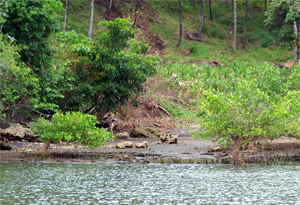
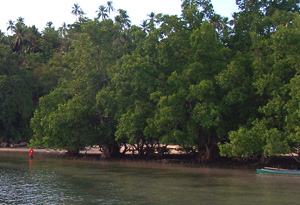
![]()